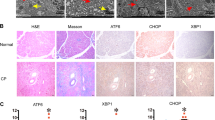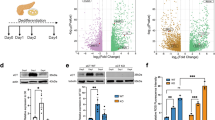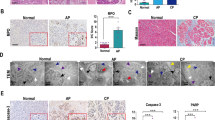Abstract
The exocrine pancreas is the organ with the highest level of protein synthesis in the adult—each day the pancreas produces litres of fluid filled with enzymes that are capable of breaking down nearly all organic substances. For optimal health, the pancreas must produce sufficient enzymes of the right character to match the dietary intake. Disruption of normal pancreatic function occurs primarily as a result of dysfunction of the acinar cells that produce these digestive enzymes, and can lead to acute or chronic diseases. For many years, the prevailing dogma has been that inappropriate intracellular activation of the digestive enzymes produced by acinar cells was the key to pancreatic inflammatory diseases, as digestive enzymes themselves are potentially harmful to the cells that secrete them. However, we now know that many stressors can affect pancreatic acinar cells, and that these stressors can independently trigger pancreatic pathology through various mechanisms. This Review focuses on protein synthesis and active digestive enzymes—two key stressors faced by the acinar cell that are likely to be the major drivers of pathology encountered in the pancreas.
Key Points
-
The pancreas is a highly active organ, primarily because it contains the acinar cells that produce digestive enzymes
-
Physiological stresses on acinar cells include those associated with high levels of protein synthesis and with the production, storage and secretion of potentially damaging digestive enzymes
-
Synthesis of secreted proteins occurs in the endoplasmic reticulum (ER) and can be affected by many factors that result in protein misfolding or ER stress
-
Several compensatory mechanisms have evolved to protect the acinar cell from ER stress and inappropriate activation of digestive enzymes
-
Under normal circumstances, the compensatory mechanisms for ER stress and digestive enzyme activation are sufficient to fully protect the cells without any decrease in function
-
At high levels of stress, these same mechanisms result in acinar cell destruction and disease
This is a preview of subscription content, access via your institution
Access options
Subscribe to this journal
Receive 12 print issues and online access
$209.00 per year
only $17.42 per issue
Buy this article
- Purchase on Springer Link
- Instant access to full article PDF
Prices may be subject to local taxes which are calculated during checkout




Similar content being viewed by others
References
Case, R. M. Synthesis, intracellular transport and discharge of exportable proteins in the pancreatic acinar cell and other cells. Biol. Rev. Camb. Philos. Soc. 53, 211–354 (1978).
Siegel, R., Naishadham, D. & Jemal, A. Cancer statistics, 2012. CA Cancer J. Clin. 62, 10–29 (2012).
Jamieson, J. D. & Palade, G. E. Synthesis, intracellular transport, and discharge of secretory proteins in stimulated pancreatic exocrine cells. J. Cell Biol. 50, 135–158 (1971).
Weng, N., Thomas, D. D. & Groblewski, G. E. Pancreatic acinar cells express vesicle-associated membrane protein 2- and 8-specific populations of zymogen granules with distinct and overlapping roles in secretion. J. Biol. Chem. 282, 9635–9645 (2007).
Schroder, M. & Kaufman, R. J. The mammalian unfolded protein response. Annu. Rev. Biochem. 74, 739–789 (2005).
Bonifacino, J. S., Suzuki, C. K. & Klausner, R. D. A peptide sequence confers retention and rapid degradation in the endoplasmic reticulum. Science 247, 79–82 (1990).
Brodsky, J. L. & McCracken, A. A. ER protein quality control and proteasome-mediated protein degradation. Semin. Cell Dev. Biol. 10, 507–513 (1999).
Trombetta, E. S. & Parodi, A. J. Quality control and protein folding in the secretory pathway. Annu. Rev. Cell Dev. Biol. 19, 649–676 (2003).
Mareninova, O. A. et al. Impaired autophagic flux mediates acinar cell vacuole formation and trypsinogen activation in rodent models of acute pancreatitis. J. Clin. Invest. 119, 3340–3355 (2009).
Cao, S. S. & Kaufman, R. J. Unfolded protein response. Curr. Biol. 22, R622–R626 (2012).
Dorner, A. J., Wasley, L. C. & Kaufman, R. J. Increased synthesis of secreted proteins induces expression of glucose-regulated proteins in butyrate-treated Chinese hamster ovary cells. J. Biol. Chem. 264, 20602–20607 (1989).
Kozutsumi, Y., Segal, M., Normington, K., Gething, M. J. & Sambrook, J. The presence of malfolded proteins in the endoplasmic reticulum signals the induction of glucose-regulated proteins. Nature 332, 462–464 (1988).
Bhagat, L. et al. Heat shock protein 70 prevents secretagogue-induced cell injury in the pancreas by preventing intracellular trypsinogen activation. J. Clin. Invest. 106, 81–89 (2000).
Kubisch, C. et al. Overexpression of heat shock protein Hsp27 protects against cerulein-induced pancreatitis. Gastroenterology 127, 275–286 (2004).
Bhagat, L. et al. Thermal stress-induced HSP70 mediates protection against intrapancreatic trypsinogen activation and acute pancreatitis in rats. Gastroenterology 122, 156–165 (2002).
Hietaranta, A. J. et al. Water immersion stress prevents caerulein-induced pancreatic acinar cell NF-κb activation by attenuating caerulein-induced intracellular Ca2+ changes. J. Biol. Chem. 276, 18742–18747 (2001).
Gupta, S. et al. HSP72 protects cells from ER stress-induced apoptosis via enhancement of IRE1α-XBP1 signaling through a physical interaction. PLoS Biol. 8, e1000410 (2010).
Beere, H. M. et al. Heat-shock protein 70 inhibits apoptosis by preventing recruitment of procaspase-9 to the Apaf-1 apoptosome. Nat. Cell Biol. 2, 469–475 (2000).
Green, G. M. et al. Role of cholecystokinin in induction and maintenance of dietary protein-stimulated pancreatic growth. Am. J. Physiol. 262, G740–G746 (1992).
Pahl, H. L. & Baeuerle, P. A. The ER-overload response: activation of NF-κB. Trends Biochem. Sci. 22, 63–67 (1997).
Zhang, K. & Kaufman, R. J. From endoplasmic-reticulum stress to the inflammatory response. Nature 454, 455–462 (2008).
Henkel, T. et al. Rapid proteolysis of IκB-α is necessary for activation of transcription factor NF-κB. Nature 365, 182–185 (1993).
Kuang, E. et al. ER Ca2+ depletion triggers apoptotic signals for endoplasmic reticulum (ER) overload response induced by overexpressed reticulon 3 (RTN3/HAP). J. Cell Physiol. 204, 549–559 (2005).
Pahl, H. L. & Baeuerle, P. A. Activation of NF-κB by ER stress requires both Ca2+ and reactive oxygen intermediates as messengers. FEBS Lett. 392, 129–136 (1996).
Belal, C. et al. The homocysteine-inducible endoplasmic reticulum (ER) stress protein Herp counteracts mutant α-synuclein-induced ER stress via the homeostatic regulation of ER-resident calcium release channel proteins. Hum. Mol. Genet. 21, 963–977 (2012).
Schreck, R., Meier, B., Mannel, D. N., Droge, W. & Baeuerle, P. A. Dithiocarbamates as potent inhibitors of nuclear factor kappa B activation in intact cells. J. Exp. Med. 175, 1181–1194 (1992).
Deng, J. et al. Translational repression mediates activation of nuclear factor kappa B by phosphorylated translation initiation factor 2. Mol. Cell Biol. 24, 10161–10168 (2004).
Gorman, A. M., Healy, S. J., Jäger, R. & Samali, A. Stress management at the ER: regulators of ER stress-induced apoptosis. Pharmacol. Ther. 134, 306–316 (2012).
Tabas, I. & Ron, D. Integrating the mechanisms of apoptosis induced by endoplasmic reticulum stress. Nat. Cell Biol. 13, 184–190 (2011).
Grimm, S. The ER-mitochondria interface: the social network of cell death. Biochim. Biophys. Acta. 1823, 327–334 (2012).
Berridge, M. J. The endoplasmic reticulum: a multifunctional signaling organelle. Cell Calcium 32, 235–249 (2002).
Huang, H. et al. Activation of Nuclear Factor-κB in Acinar Cells Increases the Severity of Pancreatitis in Mice. Gastroenterology 144, 201–210 (2012).
Aho, H. J., Koskensalo, S. M. L. & Nevalainen, T. J. Experimental pancreatitis in the rat. Sodium taurocholate-induced acute haemorrhagic pancreatitis. Scand. J. Gastroenterol. 15, 411–416 (1980).
Mizunuma, T., Kawamura, S. & Kishino, Y. Effects of injecting excess arginine on rat pancreas. J. Nutr. 114, 467–471 (1984).
Lerch, M. M. et al. Pancreatic duct obstruction triggers acute necrotizing pancreatitis in the opossum [see comments]. Gastroenterology 104, 853–861 (1993).
Seyhun, E. et al. Tauroursodeoxycholic acid reduces endoplasmic reticulum stress, acinar cell damage, and systemic inflammation in acute pancreatitis. Am. J. Physiol. Gastrointest. Liver Physiol. 301, G773–G782 (2011).
Hegewald, G., Nikulin, A., Gmaz-Nikulin, E., Plamenac, P. & Bärenwald, G. Ultrastructural changes of the human pancreas in acute shock. Pathol. Res. Pract. 179, 610–615 (1985).
Ji, B. et al. Pancreatic gene expression during the initiation of acute pancreatitis: identification of EGR-1 as a key regulator. Physiol. Genomics 14, 59–72 (2003).
Kereszturi, E. et al. Hereditary pancreatitis caused by mutation-induced misfolding of human cationic trypsinogen: a novel disease mechanism. Hum. Mutat. 30, 575–582 (2009).
Kubisch, C. H. et al. Long-term ethanol consumption alters pancreatic gene expression in rats: a possible connection to pancreatic injury. Pancreas 33, 68–76 (2006).
Lugea, A. et al. Adaptive unfolded protein response attenuates alcohol-induced pancreatic damage. Gastroenterology 140, 987–997 (2011).
Chen, J. M. et al. Evolution of trypsinogen activation peptides. Mol. Biol. Evol. 20, 1767–1777 (2003).
Beer, S. et al. Comprehensive functional analysis of chymotrypsin C (CTRC) variants reveals distinct loss-of-function mechanisms associated with pancreatitis risk. Gut http://dx.doi.org/10.1136/gutjnl-2012-303090.
Szabó, A. & Sahin-Tóth, M. Increased activation of hereditary pancreatitis-associated human cationic trypsinogen mutants in presence of chymotrypsin C. J. Biol. Chem. 287, 20701–20710 (2012).
Gaiser, S. et al. Intracellular activation of trypsinogen in transgenic mice induces acute but not chronic pancreatitis. Gut 60, 1379–1388 (2011).
Ji, B., Gaiser, S., Chen, X., Ernst, S. A. & Logsdon, C. D. Intracellular trypsin induces pancreatic acinar cell death but not NF-κB activation. J. Biol. Chem. 284, 17488–17498 (2009).
Chiari, H. Über die Selbstverdauung des menschlichen Pankreas [German]. Zeitschrift für Heilkunde 17, 69–96 (1896).
Van Acker, G. J. et al. Cathepsin B inhibition prevents trypsinogen activation and reduces pancreatitis severity. Am. J. Physiol. Gastrointest. Liver Physiol. 283, G794–G800 (2002).
Whitcomb, D. C. et al. Hereditary pancreatitis is caused by a mutation in the cationic trypsinogen gene. Nat. Genet. 14, 141–145 (1996).
Witt, H. et al. Mutations in the gene encoding the serine protease inhibitor, Kazal type 1 are associated with chronic pancreatitis. Nat. Genet. 25, 213–216 (2000).
Ohmuraya, M. et al. Autophagic cell death of pancreatic acinar cells in serine protease inhibitor Kazal type 3-deficient mice. Gastroenterology 129, 696–705 (2005).
Nathan, J. D. et al. Transgenic expression of pancreatic secretory trypsin inhibitor-I ameliorates secretagogue-induced pancreatitis in mice. Gastroenterology 128, 717–727 (2005).
Halangk, W. et al. Role of cathepsin B in intracellular trypsinogen activation and the onset of acute pancreatitis. J. Clin. Invest. 106, 773–781 (2000).
Han, B., Ji, B. & Logsdon, C. D. CCK independently activates intracellular trypsinogen and NF-κB in rat pancreatic acinar cells. Am. J. Physiol. Cell Physiol. 280, C465–C472 (2001).
Halangk, W. et al. Trypsin activity is not involved in premature, intrapancreatic trypsinogen activation. Am. J. Physiol. Gastrointest. Liver Physiol. 282, G367–G374 (2002).
Singh, V. P. & Chari, S. T. Protease inhibitors in acute pancreatitis: lessons from the bench and failed clinical trials. Gastroenterology 128, 2172–2174 (2005).
Dawra, R. et al. Intra-acinar trypsinogen activation mediates early stages of pancreatic injury but not inflammation in mice with acute pancreatitis. Gastroenterology 141, 2210–2217 (2011).
Chen, X. et al. NF-κB activation in pancreas induces pancreatic and systemic inflammatory response. Gastroenterology 122, 448–457 (2002).
Han, B. & Logsdon, C. D. Cholecystokinin induction of mob-1 chemokine expression in pancreatic acinar cells requires NF-κB activation. Am. J. Physiol. 277, C74–C82 (1999).
Ji, B. et al. Pancreatic gene expression during the initiation of acute pancreatitis: identification of EGR-1 as a key regulator. Physiol. Genomics 14, 59–72 (2003).
Ji, B. et al. Ras activity levels control the development of pancreatic diseases. Gastroenterology 137, 1072–1082, 1082 e1–6 (2009).
Acknowledgements
C. D. Logsdon's scientific research is supported by grant DK052067 and AA020822.
Author information
Authors and Affiliations
Contributions
C. D. Logsdon researched the data for the article, and wrote the manuscript. C. D. Logsdon and B. Ji contributed to discussions of its content and undertook review and editing of the manuscript before submission.
Corresponding author
Ethics declarations
Competing interests
The authors declare no competing financial interests.
Rights and permissions
About this article
Cite this article
Logsdon, C., Ji, B. The role of protein synthesis and digestive enzymes in acinar cell injury. Nat Rev Gastroenterol Hepatol 10, 362–370 (2013). https://doi.org/10.1038/nrgastro.2013.36
Published:
Issue Date:
DOI: https://doi.org/10.1038/nrgastro.2013.36
This article is cited by
-
Acid ceramidase targeting pyruvate kinase affected trypsinogen activation in acute pancreatitis
Molecular Medicine (2022)
-
A novel resveratrol analog upregulates sirtuin 1 and inhibits inflammatory cell infiltration in acute pancreatitis
Acta Pharmacologica Sinica (2022)
-
Lure-and-kill macrophage nanoparticles alleviate the severity of experimental acute pancreatitis
Nature Communications (2021)
-
Mitochondrial NADP+ is essential for proline biosynthesis during cell growth
Nature Metabolism (2021)
-
Effects of dietary active soybean trypsin inhibitors on pancreatic weights, histology and expression of STAT3 and receptors for androgen and estrogen in different tissues of rats
Molecular Biology Reports (2021)



